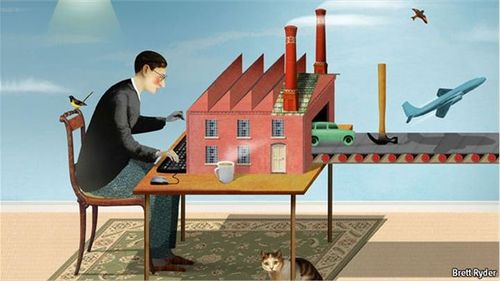Digital Fabrication
Digital fabrication is a new kind of industry that uses computer-controlled tools to turn digital designs into useful physical objects.
We've had a digital revolution.
Now let's have a digital industrial revolution.
Examples of digital fabrication technologies include the Multimachine - an open-source mill-drill-lathe. Combined with computer numerical control (CNC) of the workpiece table, it becomes a digital fabrication device capable of making metal pieces of any arbitrary shape from forks to fenders and from ballbearings to Bunsen burners. The only limit being human creativity and the designs available in the Open Hardware Repository.
The aim of the Open Ecology movement is to catalyse the new digital industrial revolution and help create what we call Industry 2.0. This certainly has implications that no one has anticipated, but some characteristics are apparent -
Digital fabrication is flexible. This allows for one machine to fulfil many roles and reduces space and resources. Industrial mass-production required a different factory for every type of product, but flexible, digital manufacturing allows the same set of tools to be use to make any electromechanical device you care to name. Flexibility makes it worthwhile to invest in your own fabrication tools; only industrialists would invest in a tool that makes the same thing over and over again, but a tool that can respond to one's needs is a tool worth having in your home.
Digital fabrication is decentralized. It is no longer necessary to have large factories where technology is made before being distributed around the world. Instead, technologies can be made locally. Essentially, the products travel most of their journey at light-speed as digitally stored data. Design is global; instantiation is local.
Digital fabrication is cheap. Once a person has fabrication machines, they can create a car, a mobile phone, agricultural equipment or whatever at the cost of raw materials. The standard industrial supply-chain greatly inflates the price of manufactured goods. If you buy a commercially-manufactured computer, your dollar has to cover the costs of mining the material, shipping the material to China, running the machines, labour, marketing, more shipping, and mark-ups by several retailers. Digital fabrication, by empowering people to manufacture their own wealth in their backyard, cuts out all those extra costs and reduces the cost to just energy plus information plus raw materials. Energy comes free from the sun and information comes free from the Internet, so the only cost is raw materials.
Digital fabrication is customizable. The Web is revolutionizing media and information services because of the ease with which users can generate their own content. The old media (TV, newspapers, radio etc.) were generally one-way channels that made it easy to be a consumer of information and difficult to become a producer. But with blogs, out-of-the-box websites, wikis and so forth, anyone can now broadcast information. Digital manufacturing represents the same revolution of user-generated content being brought to physical goods like electronics. With digital manufacturing, everyone can generate their own phone, their own computer, their own mp3 player or alarm clock. They can express their creativity in their products, rather than having to buy mass-produced ones.
Digital fabrication empowers the poor. Housing, medical equipment, agricultural equipment, electronics - let's assume that it would be a good thing to provide poor people with these things. How are we to do it? You could say there are two ways: One is to manufacture the goods in wealthier places and ship them over and the other is to manufacture them on-site where they are needed. Of these two solutions, only the second one creates local economic stimulus, teaches technological skills and makes communities economically self-sufficient.
Digital fabrication is evolving. The ultimate fruit of digital fabrication will be the Molecular assembler that rearranges atoms and puts them in place at great speed to build absolutely anything, including nanoscale robots and ham sandwiches. The current generation is a Fab Lab, a workshop of about 14 tools costing about $50,000 that can build nearly any electromechanical device. One of the core projects of the Open Ecology movement is to create the RepLab, a second-generation Fab Lab that uses only open-source hardware, is self-replicating (one RepLab can be used to build another) and costs only a fraction of what first-generation Fab Labs cost.
See Neil Gershenfeld's introductory talk on the subject:
See Also
- RepLab
- RepRap
- Rapid Prototyping
- New Culture - Personal Fabricator
- It Will Be Awesome If They Don't Screw It Up: 3D Printing, Intellectual Property, and the Fight Over the Next Great Disruptive Technology
- Homebrew Industrial Revolution - Lengthy Manifesto
- P2P Foundation - Digital Fabrication
Providers
- i.materialise (a Belgian company founded in 1990)
- Sculpteo (a Paris-based service founded in 2009) provide on-demand 3-D printing
- Customizable iPhone accessories (Glif)
- Jewelry (Nervous System)
- Cases for prosthetic limbs (Bespoke)
